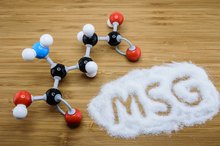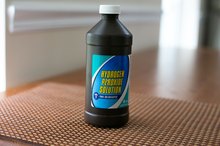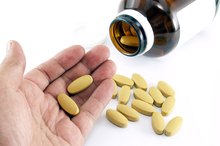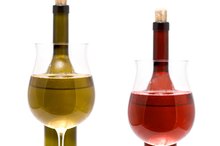What does fact checked mean?
At Healthfully, we strive to deliver objective content that is accurate and up-to-date. Our team periodically reviews articles in order to ensure content quality. The sources cited below consist of evidence from peer-reviewed journals, prominent medical organizations, academic associations, and government data.
- "Journal of Rheumatology"; Treatment of Fibromyalgia Syndrome with Super Malic: A Randomized, Double Blind, Placebo Controlled, Crossover Pilot Study
- "Journal of Rheumatology"; Treatment of Fibromyalgia Syndrome with Super Malic: A Randomized, Double Blind, Placebo Controlled, Crossover Pilot Study
The information contained on this site is for informational purposes only, and should not be used as a substitute for the advice of a professional health care provider. Please check with the appropriate physician regarding health questions and concerns. Although we strive to deliver accurate and up-to-date information, no guarantee to that effect is made.
The Sources of Malic Acid
Malic acid, or malate, is an organic compound that occurs naturally in fruits and vegetables. It is responsible for the sourness of green apples and other unripe fruit. It was first isolated in the late 18th century from apples, which belong to the genus Malus. The food and beverage industries use malic acid extensively for its tart flavor, and it has found favor as a dietary supplement for increasing energy levels, decreasing pain and improving exercise tolerance.
Uses
Malic acid is frequently added to wines and other beverages, jellies and jams, sherbets, frozen milk products and candies. One noteworthy application is in so-called “extreme candies,” in which a pocket of malic acid is buried to impart a burst of tartness. Malate, usually listed as alpha-hydroxy acid, is added to cosmetics as a skin toner. It has been used by athletes to enhance exercise efficiency and by fibromyalgia and chronic fatigue patients to alleviate pain and improve energy levels. The use of malate as a supplement presumably derives from its participation in the citric acid cycle, where it serves as an intermediary in the production of cellular energy.
- Malic acid is frequently added to wines and other beverages, jellies and jams, sherbets, frozen milk products and candies.
- Malate, usually listed as alpha-hydroxy acid, is added to cosmetics as a skin toner.
Fruits and Vegetables
Types of Citric Acid
Learn More
Arguably, the safest sources of malic acid reside in natural repositories. Apples, cherries, apricots, cranberries, peaches, rhubarb, plums, tomatoes, pears, pineapple, gooseberries and raspberries are all good food sources of malic acid. However, the level of malate in fruits and vegetables varies significantly during ripening and shipping, and these foods may not furnish sufficient amounts to meet the needs of some individuals.
Apple Cider Vinegar
Undistilled, unfiltered apple cider vinegar contains the malic acid that persists following the fermentation of apple cider. For some people, vinegar represents a more concentrated and convenient source of malic acid than fresh fruits and vegetables, but daily consumption may require an adjustment in one’s palate. The adjustment might be worth the effort, though, as apple cider vinegar is reputed to confer a plethora of health benefits. Unfortunately, most of these claims are unsubstantiated.
- Undistilled, unfiltered apple cider vinegar contains the malic acid that persists following the fermentation of apple cider.
- The adjustment might be worth the effort, though, as apple cider vinegar is reputed to confer a plethora of health benefits.
Powder
What Is Sodium Carboxymethyl?
Learn More
Malic acid is available as a powder, which is the form used by some people who wish to take large doses. In nature, malate exists in only one form, L-malate. Commercial powders often contain both D- and L-malate as well as variable levels of impurities, but purified L-malate is also available. Food-grade malic acid powder is offered by a number of vitamin and supplement manufacturers.
- Malic acid is available as a powder, which is the form used by some people who wish to take large doses.
- Commercial powders often contain both D- and L-malate as well as variable levels of impurities, but purified L-malate is also available.
Capsules
Encapsulated malic acid powder is available in a range of strengths from 300 to 800 milligrams. It is often combined with magnesium, which may improve its effectiveness for certain conditions. Daily dosing recommendations vary, so users should follow the manufacturer’s directions or consult a health care provider.
Others
Malic acid is supplied in liquid and tablet forms by several supplement manufacturers. Some of these preparations may contain other nutrients, such as B vitamins, magnesium or manganese. The form of malic acid used is a matter of personal preference, convenience and response.
Precautions
Malic acid is generally regarded as safe, when it is used according to proper dosing guidelines. Large or frequent doses of powder can cause oral irritation, and gastrointestinal upset was reported by some test subjects in a study published in the "Journal of Nutritional Medicine." Until more information is available, pregnant women and growing children should avoid supplementation with malic acid 2. Individuals with sensitive skin should consider applying test patches of alpha hydroxy acid-containing products.
- Malic acid is generally regarded as safe, when it is used according to proper dosing guidelines.
- Until more information is available, pregnant women and growing children should avoid supplementation with malic acid 2.
Related Articles
References
- "Journal of Chemical Education"; The Origin of the Names Malic, Maleic and Malonic Acid
- "Journal of Nutritional Medicine"; Management of fibromyalgia: A Rationale for the Use of Magnesium and Malic Acid
- "Journal of Rheumatology"; Treatment of Fibromyalgia Syndrome with Super Malic: A Randomized, Double Blind, Placebo Controlled, Crossover Pilot Study
- Taylor MB, Yanaki JS, Draper DO, Shurtz JC, Coglianese M. Successful short-term and long-term treatment of melasma and postinflammatory hyperpigmentation using vitamin C with a full-face iontophoresis mask and a mandelic/malic acid skin care regimen. J Drugs Dermatol. 2013 Jan;12(1):45-50.
- Tyka AK, Chwastowski M, Cison T, et al. Effect of creatine malate supplementation on physical performance, body composition and selected hormone levels in spinters and long-distance runners. Acta Physiol Hung. 2015 Mar;102(1):114-22. doi:10.1556/APhysiol.102.2015.1.12
- Rodgers AL, Webber D, de Charmoy R, Jackson GE, Ravenscroft N. Malic acid supplementation increases urinary citrate excretion and urinary pH: implications for the potential treatment of calcium oxalate stone disease. J Endourol. 2014 Feb;28(2):229-36. doi:10.1089/end.2013.0477
- Manfredini R, De giorgi A, Storari A, Fabbian F. Pears and renal stones: possible weapon for prevention? A comprehensive narrative review. Eur Rev Med Pharmacol Sci. 2016;20(3):414-25.
- Russell IJ, Michalek JE, Flechas JD, Abraham GE. Treatment of fibromyalgia syndrome with Super Malic: a randomized, double blind, placebo controlled, crossover pilot study. J Rheumatol. 1995;22(5):953-8.
- Gómez-Moreno G, Aguilar-Salvatierra A, Guardia J, et al. The efficacy of a topical sialogogue spray containing 1% malic acid in patients with antidepressant-induced dry mouth: a double-blind, randomized clinical trial. Depress Anxiety. 2013 Feb;30(2):137-42. doi:10.1002/da.22017
- Tang SC, Yang JH. Dual Effects of Alpha-Hydroxy Acids on the Skin. Molecules. 2018;23(4). doi:10.3390/molecules23040863
Writer Bio
Stephen Christensen started writing health-related articles in 1976 and his work has appeared in diverse publications including professional journals, “Birds and Blooms” magazine, poetry anthologies and children's books. He received his medical degree from the University of Utah School of Medicine and completed a three-year residency in family medicine at McKay-Dee Hospital Center in Ogden, Utah.









